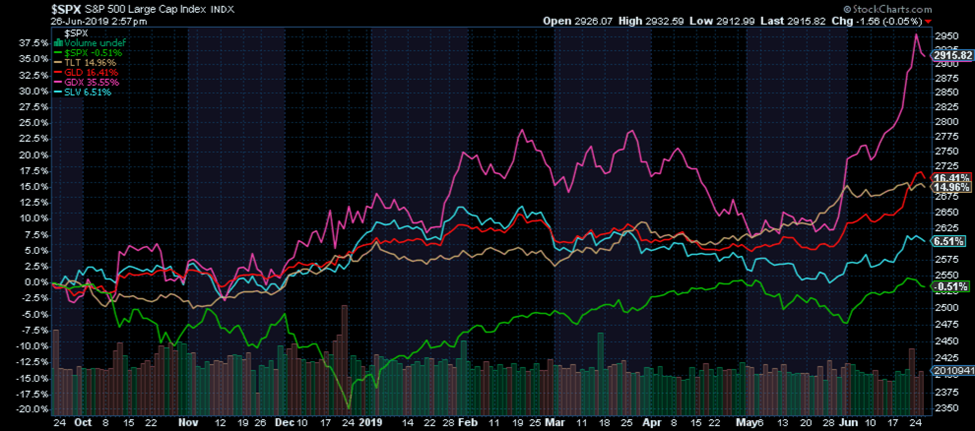As we’ve discussed with clients for a couple years now, the outlook for precious metals has been steadily improving. From a price or relative value standpoint, they’ve seldom been cheaper relative to financial assets and as we’ve stressed, long-term investment performance is all about the price we pay for something. From a fundamental standpoint, the potential for precious metals to provide investors, governments, and the global populace in general with peace of mind and a reasonably stable store of value has probably never been better. Here’s why, as we touched on above:
Central banks are ten years into an economic expansion (granted one of the weakest on record) fueled by low rates and liquidity injections via quantitative easing (QE), yet we still have more debt and greater deficits than at any other time in history. As a result, governments and central banks have put themselves in a position where they can’t raise rates in a meaningful way without the system breaking. Europe hasn’t been able to raise rates at all, and although we’ve raised them here in the U.S., the economy is already showing signs of distress with rates still at historically low levels. With the effective federal funds rate at 2.4%, and stock markets near all-time highs, the Federal Reserve is prepared to not only lower rates at the first signs of trouble, but to do “whatever it takes” to keep the expansion going. To us, this is a clear sign that there is no exit from aggressive central bank intervention. It has proven to be the Hotel California as sung about by the Eagles – “You can check out any time you’d like, but you can never leave”. Although they might talk about normalizing rates at some point in the future, follow-through has proven difficult if not impossible.
The circular thinking goes like this…We’ll raise rates and reduce our balance sheets (take that newly printed money back out of the system) once the economy improves and inflation picks up meaningfully. Only, that doesn’t happen as quickly as planned since all the easy money has created massive amounts of debt and inefficiency from malinvestment which tends to be deflationary – it inhibits strong organic growth. Perversely, this creates the appearance that more intervention is needed and so the withdrawal of monetary accommodation is delayed or limited.
In the event a withdrawal of stimulus is attempted, rapid weakening in the economy and markets makes the effort short-lived. Whatever economic activity existed before the withdrawal of stimulus was based on that stimulus. It only makes sense that without it, things will begin to break; no different than how the human body would feel without a drug it has grown dependent on. In addition, and this is the real crux of the issue, the rise in interest rates makes it harder for those with greater levels of debt to meet their interest payments. However, the longer borrowing rates are kept low, the more debt accumulates making it eventually impossible to raise rates in any meaningful way without really nasty consequences for indebted individuals, corporations, and governments.
Interest rates in the U.S. right now are below half of what they have averaged historically. Now think about the payments you have toward car loans, mortgages, and other debt and imagine how those payments would change if your interest rates doubled. It would be equally painful for corporations and governments. This is the trap central banks have gotten themselves into. There is no clean exit.
On a more optimistic note, this is probably one of the most favorable environments for precious metals over the longer term. Whether a deflationary or inflationary situation ensues first, precious metals could provide refuge as assets and fiat currencies experience tremendous volatility. Pair this with favorable valuations relative to financial assets and we have some very compelling long-term investment potential.
What’s more, since the market peak last September, precious metals along with Treasury bonds have outperformed the stocks by a healthy margin. This represents a very nice momentum shift that has rewarded investors who have been patient and disciplined enough to position themselves early. As you can see in the chart below, regardless of all the focus on new highs in the stock market, precious metals have staged a very stealthy run over the last nine months. As the current cycle plays out along with all its unique challenges, the momentum shift across these asset categories could well represent just the beginning of a longer-term multi-year trend. Of course, as with anything, investing in precious metals can be risky and volatile and should be part of a broader, well-defined investment strategy. Everything has the potential to go down in price over different periods of time. The goal is to invest in those things that have more up than down still ahead of them. After all, it’s not what’s in the rearview mirror that matters, but rather what we see on the road ahead.
Editors Note: This article was originally published in the July 2019 edition of our “Cadence Clips” newsletter.



